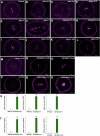Regulation and function of a polarly localized lignin barrier in the exodermis
- PMID: 39623209
- PMCID: PMC11757151
- DOI: 10.1038/s41477-024-01864-z
Regulation and function of a polarly localized lignin barrier in the exodermis
Abstract
Multicellular organisms control environmental interactions through specialized barriers in specific cell types. A conserved barrier in plant roots is the endodermal Casparian strip (CS), a ring-like structure made of polymerized lignin that seals the endodermal apoplastic space. Most angiosperms have another root cell type, the exodermis, that is reported to form a barrier. Our understanding of exodermal developmental and molecular regulation and function is limited as this cell type is absent from Arabidopsis thaliana. We demonstrate that in tomato (Solanum lycopersicum), the exodermis does not form a CS. Instead, it forms a polar lignin cap (PLC) with equivalent barrier function to the endodermal CS but distinct genetic control. Repression of the exodermal PLC in inner cortical layers is conferred by the SlSCZ and SlEXO1 transcription factors, and these two factors genetically interact to control its polar deposition. Several target genes that act downstream of SlSCZ and SlEXO1 in the exodermis are identified. Although the exodermis and endodermis produce barriers that restrict mineral ion uptake, the exodermal PLC is unable to fully compensate for the lack of a CS. The presence of distinct lignin structures acting as apoplastic barriers has exciting implications for a root's response to abiotic and biotic stimuli.
© 2024. The Author(s).
Conflict of interest statement
Competing interests: The authors declare no competing interests.
Figures















References
-
- Enstone, D. E., Peterson, C. A. & Ma, F. Root endodermis and exodermis: structure, function, and responses to the environment. J. Plant Growth Regul.21, 335–351 (2002).
-
- Roppolo, D. et al. A novel protein family mediates Casparian strip formation in the endodermis. Nature473, 380–383 (2011). - PubMed
-
- Lee, Y., Rubio, M. C., Alassimone, J. & Geldner, N. A mechanism for localized lignin deposition in the endodermis. Cell153, 402–412 (2013). - PubMed
Publication types
MeSH terms
Substances
Associated data
- Actions
Grants and funding
- HHMI 55108506/Howard Hughes Medical Institute (HHMI)
- 55108506/Howard Hughes Medical Institute (HHMI)
- NSF 2118017/National Science Foundation (NSF)
- PGRP IOS-211980/National Science Foundation (NSF)
- PGRP IOS-1856749/National Science Foundation (NSF)
- PRFB IOS-1907008/National Science Foundation (NSF)
- 655406/EC | EU Framework Programme for Research and Innovation H2020 | H2020 Priority Excellent Science | H2020 European Research Council (H2020 Excellent Science - European Research Council)
- 700057/EC | EU Framework Programme for Research and Innovation H2020 | H2020 Priority Excellent Science | H2020 European Research Council (H2020 Excellent Science - European Research Council)
- FI-570-2018/United States - Israel Binational Agricultural Research and Development Fund (BARD)
- RGP0067/2021/Human Frontier Science Program (HFSP)
- Long-term Fellowship ALTF 1046-2015/European Molecular Biology Organization (EMBO)
LinkOut - more resources
Full Text Sources
Molecular Biology Databases
Miscellaneous

